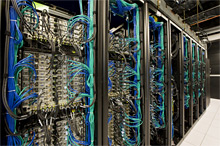Computing
High-performance Computing
A workstation computer can perform billions of multiplication and addition operations each second. High-performance parallel computing becomes necessary when computations become too large or too long to complete on a single such machine. In parallel computing, computations are divided up so that many computers can work on the same problem at once.
Lattice Quantum Chromodynamics, or Lattice QCD, is one area of scientific research where many of the most interesting problems require parallel computations.
Quantum chromodynamics is the study of how quarks and gluons interact through the strong force. This requires the study of interactions at distances smaller than the diameter of a proton, about 10^-15 meters across.
Experimental physicists do not observe quarks in isolation in their detectors but instead bound together to form particles such as protons, kaons and pions. Predicting the properties of these particles requires Lattice QCD.
In Lattice QCD computations, physicists replace continuous space-time with a four-dimensional lattice that represents the three dimensions of space plus a dimension of time. The space-time box is made big enough for a proton to fit inside. Just as our brains only take in part of the information available to us to build our perception of our surroundings, computers completing LQCD calculations produce a sequence of snapshots of QCD from which averages of quantities such as particle masses or decay rates are computed.
Physicists use Lattice QCD to make predictions of masses and decay rates. They then compare those predictions to measurements from experiments. Physicists look carefully for any inconsistencies between experiment and the theoretical predictions. Such inconsistencies might be an exciting hint of new physics beyond the Standard Model.
- Last modified
- 03/19/2015
- email Fermilab


